

Beginner’s Guide: Understanding Metering Mode- [Canon Hongkong Company Limited] Learning to use your light meter — Cornicello Photography. This is all well and good for photography lit by continuous light sources like the sun, incandescent lights, LED lights, etc.
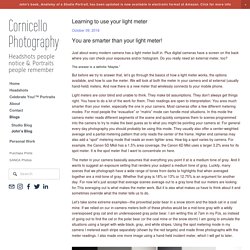
How to Read Image Histograms. Reading histograms is an important skill to acquire in the world of digital photography.
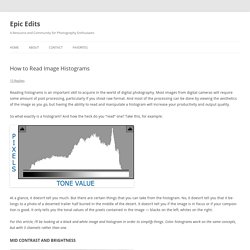
Most images from digital cameras will require some amount of post processing, particularly if you shoot raw format. And most of the processing can be done by viewing the aesthetics of the image as you go, but having the ability to read and manipulate a histogram will increase your productivity and output quality. So what exactly is a histogram? Scherptediepte in de praktijk. Inleiding.

Understanding Canon 5D Mark IV Autofocus - AF Points & AF Areas. In our previous post about the Canon 5D Mark IV, we covered the basics of how auto focus works for still photography and the different auto focus modes.

If you're wondering what One-Shot AF, AI Focus, or AI Servo means on your camera, that post is for you. HDR, tonemapping, free HDR software, gratis HDR software. Shutter Speed Chart & Photography Guide [Updated 2018] – Dave Morrow Photography. Download the Free Shutter Speed Chart PDF, for reference, while reading the in-depth photography guide, below.
![Shutter Speed Chart & Photography Guide [Updated 2018] – Dave Morrow Photography](http://cdn.pearltrees.com/s/pic/th/shutter-photography-updated-185246273)
Shutter speed photography settings, combined with ISO, and f-stop (controls aperture), give the photographer ultimate creative control over the photograph & the exposure triangle. Shutter speed photography settings control two important factors within an image: Motion Blur: Example, smooth water produced by long shutter speeds or fast moving objects frozen with sharp focus, produced by short shutter speeds.Image Brightness: Length of time light is exposed to the camera sensor, which determines the overall exposure. Below, you’ll learn how shutter speed works & the best shutter speed settings to produce the correct exposure for any shooting situation. Table of Contents. Licht. How to use spot metering for more accurate exposures. What is spot metering, you might be asking yourself if you are new to photography?
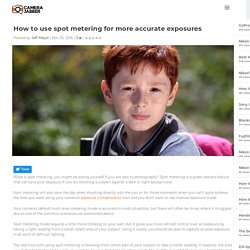
Spot metering is a great camera feature that can save your exposure if you are shooting a subject against a dark or light background. How To Use Partial Metering - SLR Photography Guide. Partial Metering Partial metering is one of four modes found mostly on Canon cameras to help measure a subject’s brightness.
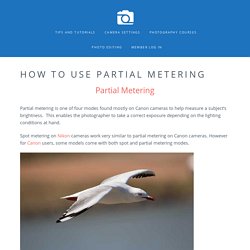
This enables the photographer to take a correct exposure depending on the lighting conditions at hand. Spot metering on Nikon cameras work very similar to partial metering on Canon cameras. Camera FAQ #9: What Kind of Scenes Should I Use AE Lock For? Camera Basics #7: Metering. Licht meten en belichten voor de beste foto. Pinhole Photography - Zoe Deaves' photography GCSE portfolio. A Brief History of Photography and the Camera.
Photography has come a long way in its relatively short history.
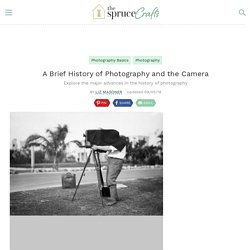
In almost 200 years, the camera developed from a plain box that took blurry photos to the high-tech mini computers found in today's DSLRs and smartphones. The story of photography is fascinating and it's possible to go into great detail. However, let's take a brief look at the highlights and major developments of this scientific art form. The First Cameras The basic concept of photography has been around since about the 5th century B.C.E. Even then, the camera did not actually record images, it simply projected them onto another surface. The first camera obscura used a pinhole in a tent to project an image from outside the tent into the darkened area. The First Permanent Images Photography, as we know it today, began in the late 1830s in France. Process: The First Photograph.
Early Experiments with Lithography The term "heliography" was coined by Joseph Nicéphore Niépce to identify the process by which he obtained his earliest photographic images.

Niépce began experimenting with lithographic printmaking—which led to his invention of heliography—because of his inability to draft images by hand. During his trials with lithography, he experimented with light-sensitive varnishes and then with images produced in camera, but he was unable to prevent the images from fading. Niépce discovered that he produced his best results while using a solution of bitumen of Judea, which dated back to the ancient Egyptians but continued to be used for making lithographic engravings in the 1800s. Photomechanical Reproduction In 1822, Niépce successfully made a heliograph from an engraving of Pope Pius VII, which was destroyed during an attempt to copy it some years later. About Bokeh. About BokehWhat is Bokeh?

Bokeh is a term, originally from Japanese (暈す-to blur; or ぼけ), that has come to mean the subjective aesthetic quality of the out of focus area of an image. Two key terms in this definition are SUBJECTIVE and IMAGE. One cannot measure bokeh, as it is something that may be pleasing to one person and not another. I have my opinion of what makes for good bokeh, and, as I own this site, I get to define good and bad Bokeh for the purposes here! The other key term is “image.” Bokeh of an IMAGE is highly dependent on the lighting of a scene, distance between lens, subject and background, how much contrast is in a background scene, how much the background contributes to an image (maybe you WANT the background to be partially visible), how busy the background is, as well as lens factors, as well.
The Oldest Photograph of People. DSLR Autofocus Modes Explained. Most modern digital SLR cameras are equipped with advanced autofocus systems that are often hard to understand. Whether you are shooting with an entry-level or professional DSLR, knowing how to use autofocus system effectively is essential to get sharp images. A badly-focused, blurry image can ruin a photograph and you cannot repair it in post-processing. Some professionals often end up converting their images to black and white, to hide their focusing problems. Easy exercise to learn to control your flash and visualise the power of light - Academy of Photography. See with your own eyes how flash works This an easy exercise to teach you how to control your flash and conquer your fears. doing our simple shots in your own way with your own, flashgun, will help you understand how much light you are going to get, and how powerful it will be.
I believe this simple flash photography tutorial is the easy way to learn The exercise consists of photographing the flash gun directly in action by using a wireless trigger. We can compare first hand all the power settings, and how light will be casted by the flash gun. On top of that you will visualise how wide the light cone will be by controlling the flash zoom. I believe this is the way to go. So grab your flash, mount it on a tripod and shoot a blank wall. Blazepress.